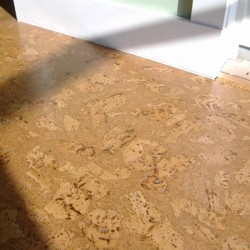Installing Cork Flooring
Cork flooring is supposed to be one of those new-fangled ‘wonder floors’ that has all the properties of vinyl flooring, yet remains ecologically sound. While I disagree with this hyperbole, installing cork flooring is one of the more interesting things you can do for your house, and it certainly is a conversation piece. But is cork flooring everything they say it is?
Cork flooring is 100% natural, no additives, resins. It comes from southern Europe and northern Africa, and yes, it really is cork–just like the cork in your wine bottles. Cork bark is very thick, so after about 10 years, it can be sliced away from the tree and used to plug up your Chateau Rothschild…or your kitchen floor.
Cork floor feels just like padded vinyl flooring when it’s installed. It does have a certain “soft” feeling or bounce under foot, though not as much as you might expect. Do not expect this to feel like those resilient rubber mats that you find at gyms.
Cork does not do well in highly moist places like bathrooms or any place where the humidity is 65% or more. If you must install in bathrooms, make sure you have good ventilation.

Cork Flooring Sizes
Just like with its sister resilient flooring, vinyl, you’ll find that cork flooring comes in the usual dimensions:
- 12″x12″ wide
- 24″x24″ wide
- Plank-size cork at 12″x36″
Cork planks are not cork through-and-through. Cork planks have fiberboard in the middle of a cork “sandwich” for greater structural stability.
Thicknesses of cork are:
- 3/16″
- 5/16″
Preparing Subfloor for Cork
You won’t find a lot of cork-specific subfloor instructions. You’ll pretty much want to prepare the subfloor/underlayment just as you would any wood or concrete.
Make sure that either base is clean, flat, smooth, and level.
Moisture can really damage cork flooring, so make sure that the concrete has a moisture level of no more than 5% before installation.
Cork Flooring Finishes
One thing that homeowners may not know is that cork flooring is finished much in the same way that wood flooring is finished. You can stain cork flooring. In fact, you can even manually sand portions of cork flooring lightly, if using very fine paper such as 150-grit. No, you won’t want to sand the entire cork floor; just a few spots that might need it.
Cork flooring will take conventional polyurethene finish (again, just as you would do for wood flooring).
If you’re a glutton for punishment, you can even finish your cork flooring with wax. Apply paste wax to the cork surface; buff it out; apply again and buff again.